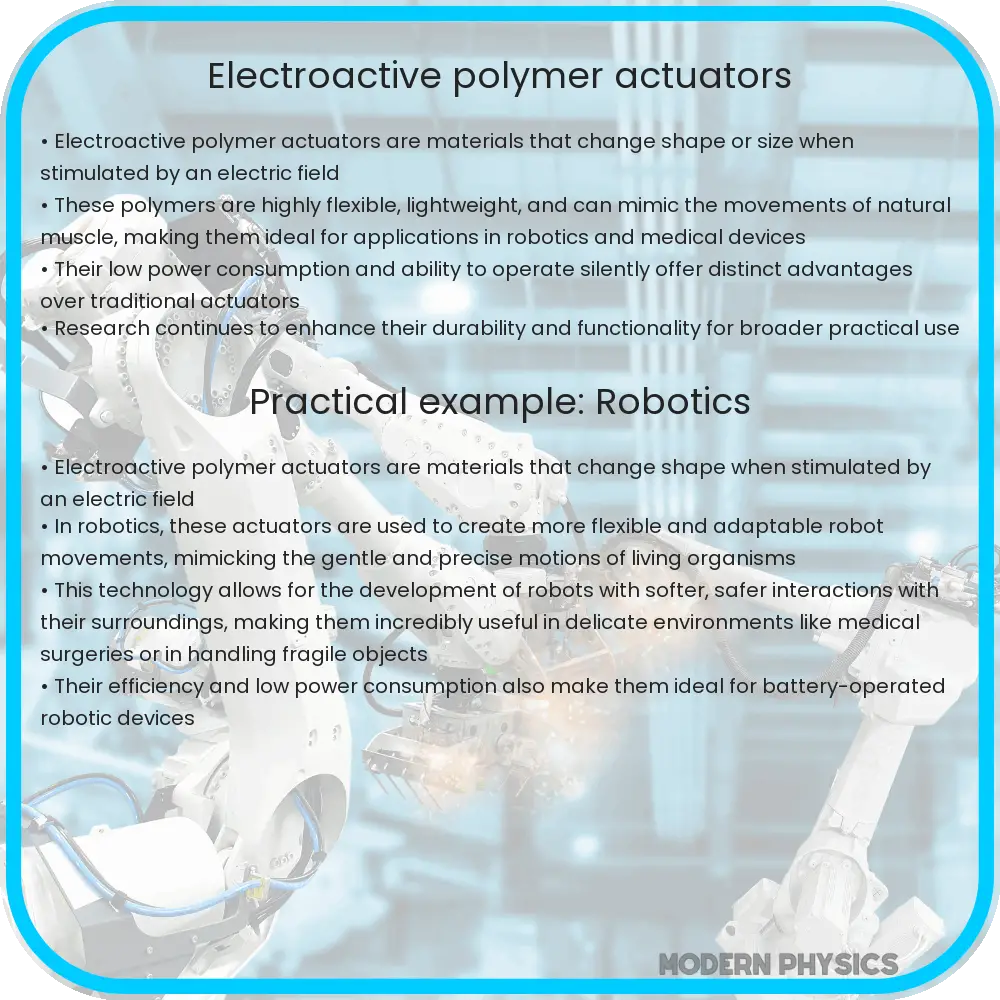Electroactive polymer actuators (EPAs) are smart materials that change size or shape under electric stimulation, offering high efficiency and flexibility.

Introduction to Electroactive Polymer Actuators
Electroactive polymer actuators (EPAs) are a class of smart materials that undergo significant changes in size or shape when stimulated by an electric field. These unique materials have caught the attention of researchers and engineers because of their flexibility, efficiency, and potential applications across various fields of technology. Primarily made from polymers, EPAs mimic the action of natural muscle, providing a soft, flexible, and adaptive response to electrical input.
The Basics of Electroactive Polymer Actuators
To understand how EPAs work, it is crucial to delve into their composition and the principles behind their operation. Electroactive polymers are generally composed of large, chain-like molecules whose structure can be easily altered by electric stimulation. This ability to change shape or size predominantly depends on the specific type of EPA. There are two main types of electroactive polymers:
- Dielelectric elastomers: These are soft, insulating materials that can undergo large strains. They function similarly to capacitors, wherein applying a voltage causes the polymer to compress and expand laterally. The deformation is due to the electrostatic forces generated between the compliant electrodes on either side of the elastomer layer.
- Conductive polymers: In these materials, electric current causes ions to move through the polymer, leading to volume changes mostly through solvent swelling or actuation. This type can also display changes in color or transparency, adding to their versatility.
The mechanisms by which these materials operate make them exceptionally suitable for applications requiring precise control and significant material deformation.
Advantages of Using Electroactive Polymers
EPAs offer several advantages over traditional actuation mechanisms like hydraulic, pneumatic, and metallic actuators:
- High efficiency: They can convert electrical energy into mechanical energy with high efficiency, often surpassing the performance of traditional actuators.
- Lightweight: Polymers are inherently lighter than metals, making EPAs ideal for applications where weight is a critical factor.
- Flexibility: Their inherent flexibility enables the design of devices that can perform complex, delicate movements, much like biological muscles.
- Quiet operation: Unlike conventional actuators, EPAs operate silently, which is beneficial for environments where noise is a concern.
These properties make electroactive polymers incredibly appealing for pioneering fields such as soft robotics, wearable technology, and biomimetic devices. The next sections will further explore the innovative applications of these materials and their impact on future technological advancements.
Innovative Applications of Electroactive Polymers
The unique properties of electroactive polymers have paved the way for their inclusion in numerous innovative applications. Here are some notable areas where EPAs are making a significant impact:
- Soft Robotics: In robotics, EPAs offer the ability to create more lifelike and adaptable movements. This is particularly useful in robots designed to operate in unstructured environments where flexibility and gentleness are paramount.
- Biomedical Devices: Electroactive polymers are used in the development of new minimally invasive medical devices that can conform to the shapes and movements of the human body, enhancing both functionality and patient comfort.
- Energy Harvesting: Due to their ability to deform, these polymers can also be used in energy harvesting devices. Mechanical energy from environmental sources like wind or waves can be converted into electrical energy through the movement of these polymers.
- Artificial Muscles: Perhaps one of the most exciting applications is in the field of prosthetics where EPAs serve as artificial muscles, providing movements that closely mimic natural muscle action.
Each of these applications demonstrates the versatility of electroactive polymers and the breadth of possibilities they open up for future technological improvements and innovations. The next section will delve into the challenges faced in the development and implementation of EPAs and potential solutions to these issues.
Challenges and Future Directions in Electroactive Polymer Technology
Despite the significant advantages and promising applications of electroactive polymers, there are challenges that need to be addressed to fully realize their potential. These include:
- Material Durability: Continuous operation can lead to material fatigue and degradation, reducing the lifespan of the polymer. Enhancing the durability of these materials is crucial for their long-term application.
- Scaling: While EPAs perform well on a small scale, scaling them up to larger applications poses considerable challenges. Issues such as maintaining performance efficiency and material integrity at a larger scale need to be resolved.
- Sensitivity to Environmental Conditions: Electroactive polymers can be sensitive to environmental factors like temperature and humidity, which might alter their performance. Developing materials that are less susceptible to environmental changes is essential for their widespread use.
- Cost and Fabrication Complexity: The production of high-quality electroactive polymers can be costly and complex, involving sophisticated fabrication processes. Simplifying these processes and reducing costs will be key to making these technologies accessible for widespread use.
Addressing these challenges requires ongoing research and collaboration between scientists, engineers, and industry stakeholders. By overcoming these hurdles, the future of electroactive polymers looks promising, with potential breakthroughs and wider applications on the horizon.
Conclusion
Electroactive polymer actuators stand at the forefront of modern materials science, offering a blend of versatility, efficiency, and innovation. From robotics to biomedical devices, these materials are setting the stage for significant advancements in a variety of fields. As research continues to evolve and address the existing challenges, the scope of EPA technology is bound to expand, paving the way for revolutionary applications that could transform our approach to design, manufacturing, and interaction with the physical world. By fostering a deeper understanding and continued investment in this technology, society can look forward to solutions that are not only more effective but also more aligned with the natural and technological ecosystems of the future.
